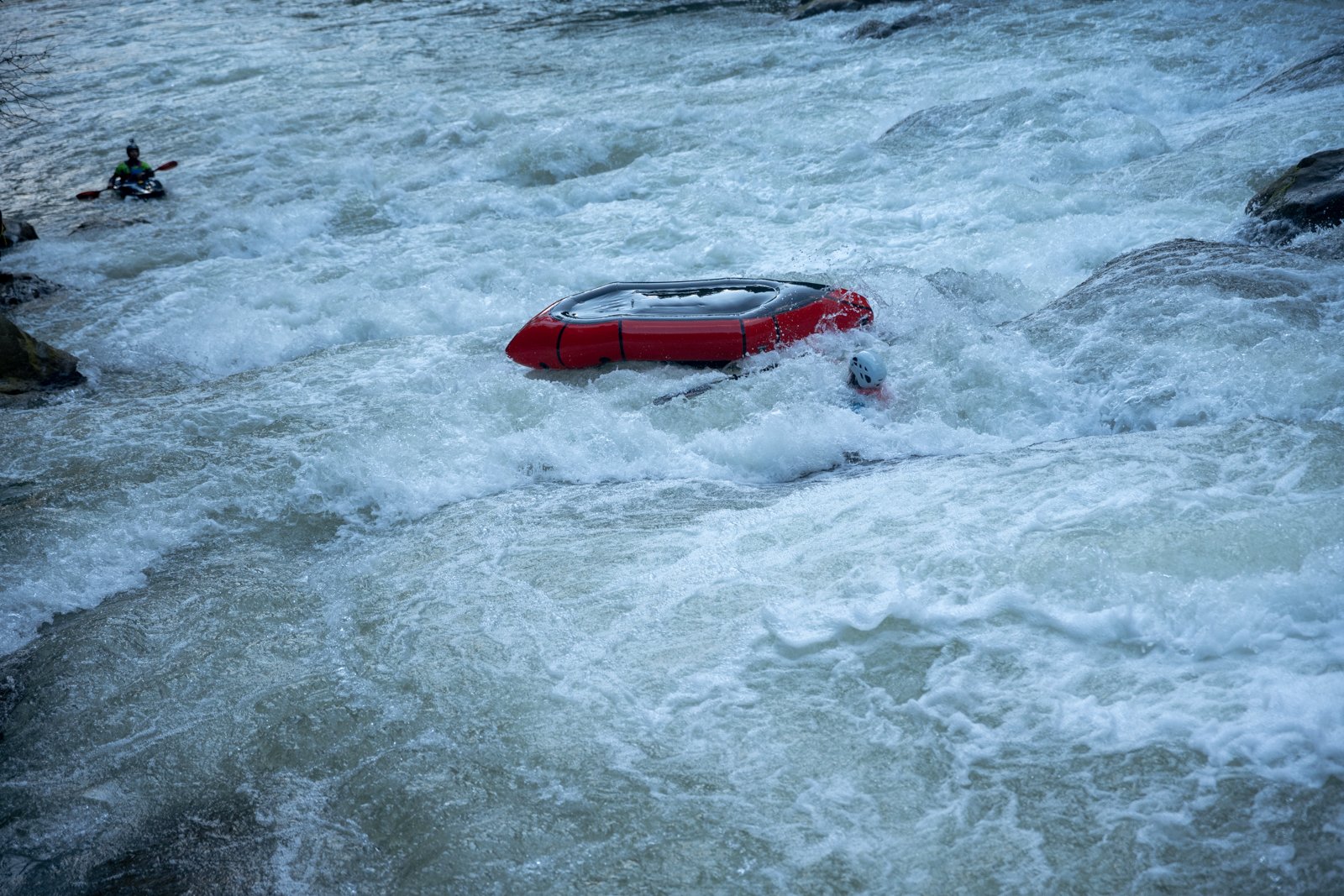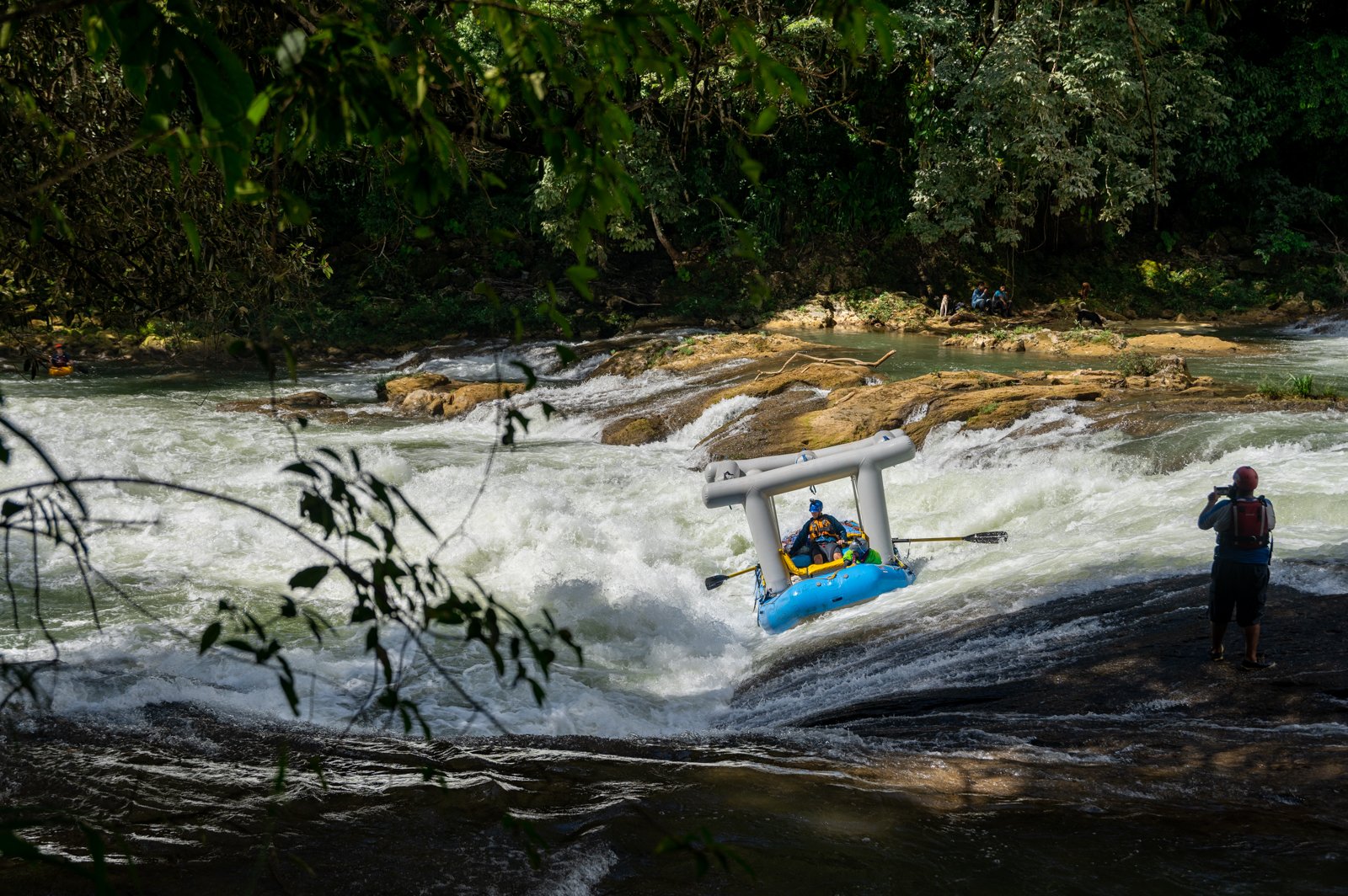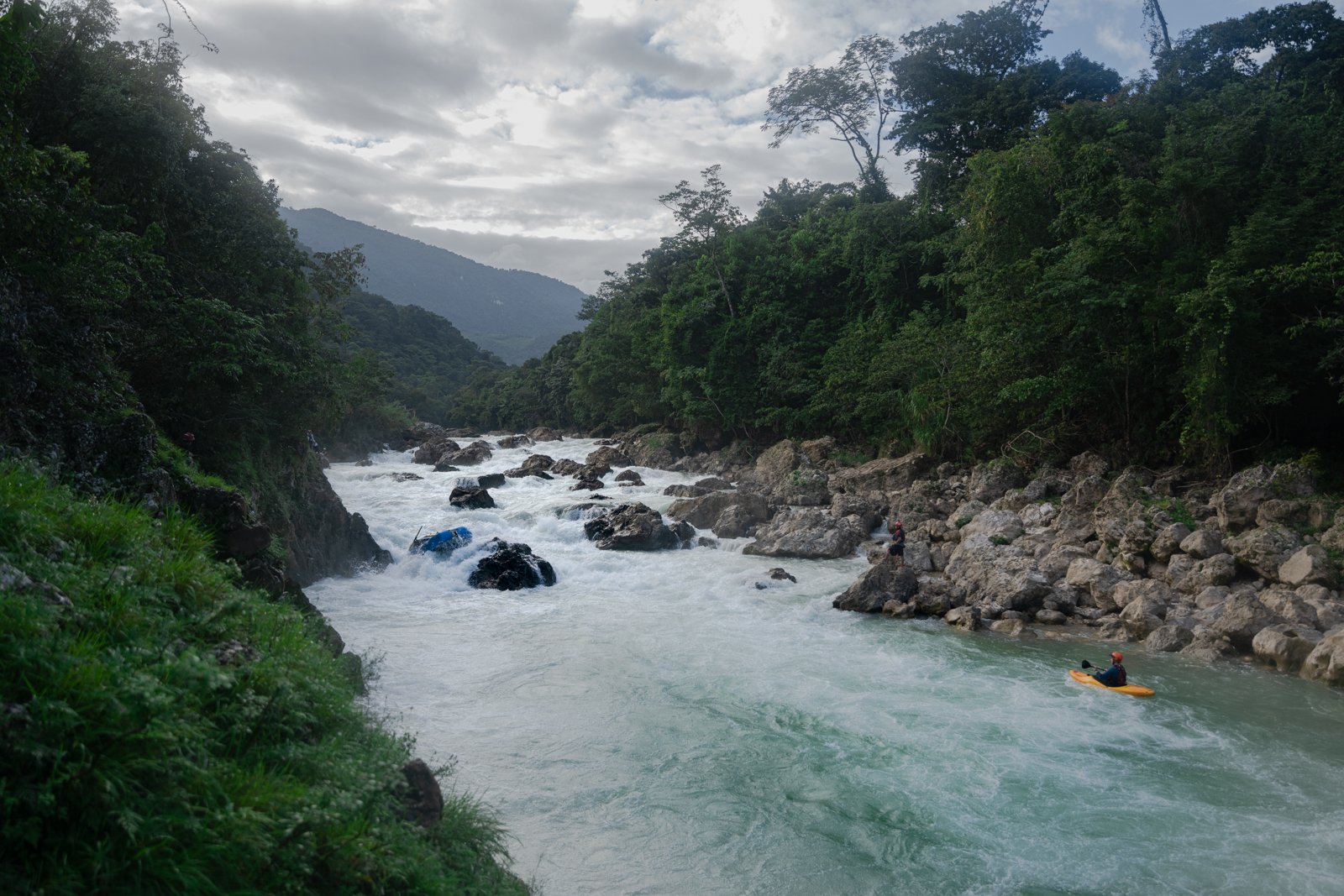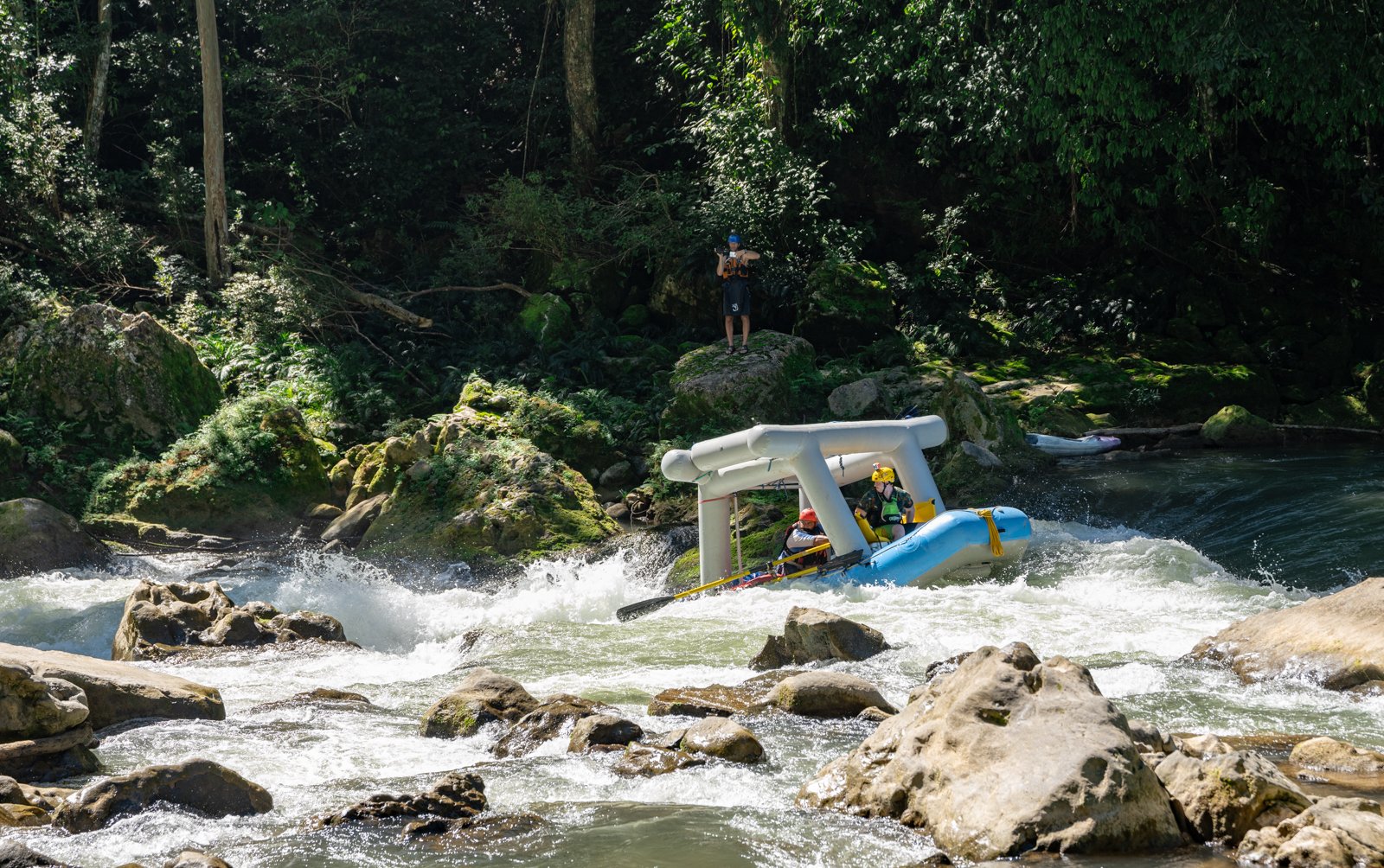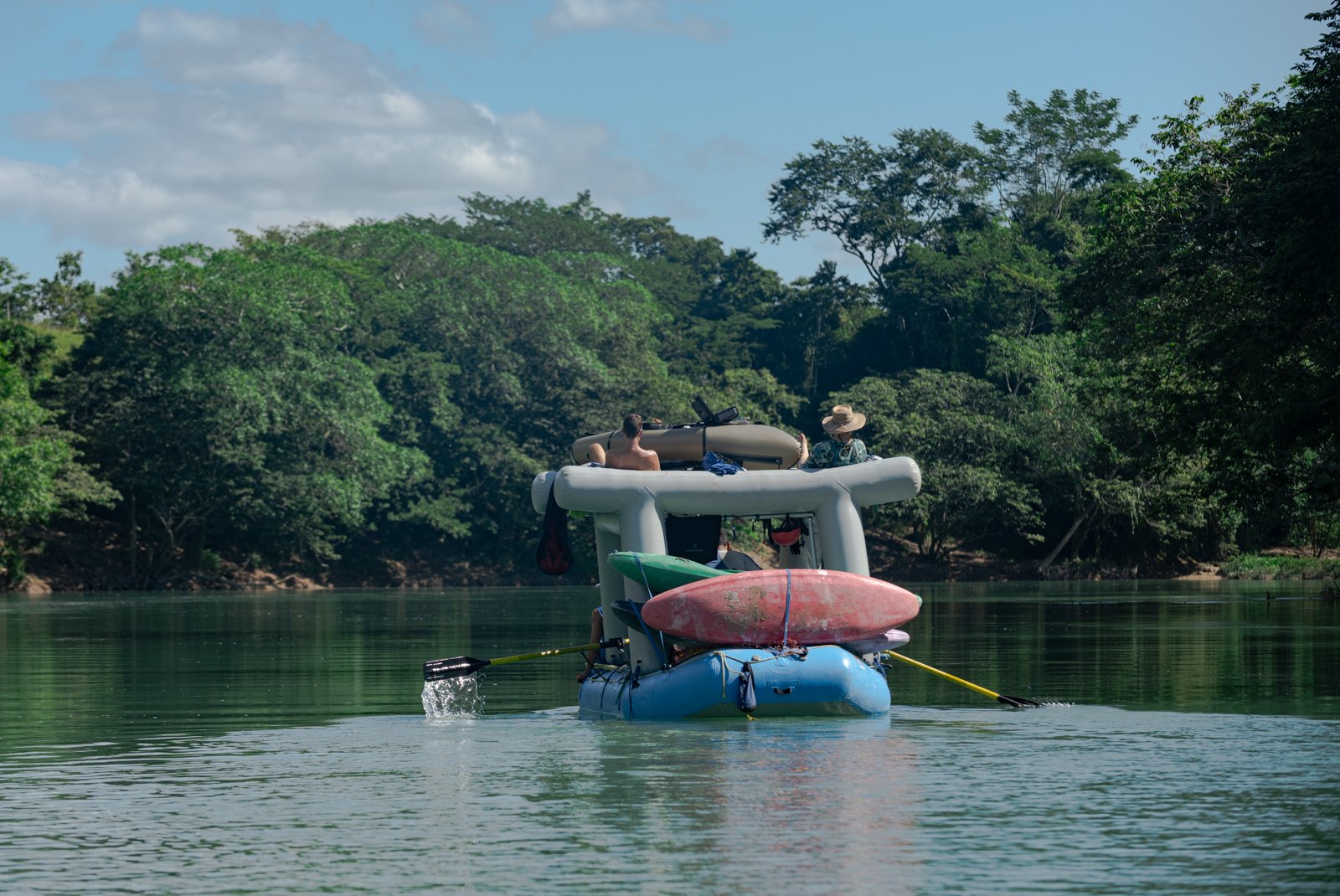Tolls, teeth & turbulence from deep in the Mexican jungle.
This story appeared in print for Mountain Gazette, issue 197.
The mood changes when the sun goes down. There’s urgency, a sense that we ought to put our guards up. The afternoon was nothing short of a booze cruise. For hours, we’ve been drinking beers, making jokes, and soaking up the sun like high schoolers on spring break. But now, the atmosphere feels different. It is far from carefree. After all, we’re strangers in an unfamiliar land; foreigners in a place that we’re not sure is all that happy to have us.
German (pronounced Her-mahn) rows the lead boat. As an assistant guide, he’s been on this river once before. He puts his headlamp on backward so we can follow him. But, German is built like a tank, and he rows like a four-stroke motor. With every passing minute, the red beacon atop his head flickers smaller and more distant. Pretty soon, we can’t see it at all.
Then, our main flotilla starts to separate. One raft powers ahead to keep pace with German. Two captains in the back, relatively unconcerned with staying together, linger behind. A boat in the middle attempts, unsuccessfully, to keep eyes on everyone. After a few uneasy kilometers, we round the corner to see the red light once again. German is parked in an eddy on river left. Above him, a white spotlight cuts the darkness and shines down into the river. With the glow directed toward us, it’s impossible to make out details, but dozens of silhouettes line the bank, everyone from grown men to women holding infants.
Carlos, another assistant guide, paddles upriver in his kayak and briefly attempts to make sure we’re all accounted for. “Ok, guys! Get to the side of the river and hang out,” he insists. “We are trying to figure out if we can camp here.” Up ahead, there is a clatter of conversation. The kind of muffled noise you hear at large gatherings. It’s too faint to make out specific words, but a lot of it is in Tzeltal, a Mayan dialect, so most of us wouldn’t be able to understand it anyway.
Branches snap in the bushes directly above us. Footsteps in the trees. Whispers. Awkward grunts in the understory.
“My balls are tingling,” Sarge says, attempting to keep the mood light. “I feel very out of my comfort zone,” adds Sam. “And that’s exactly why we do these trips.”
Twenty minutes goes by. It feels more like an hour. Then, we get the word. There’s flat ground on the other side of the river. We can camp there, the villagers say. Negotiations will continue in the morning.
THE annual river trip. For a lot of us, it’s the best time of year. An opportunity to reconnect with old friends, make new ones, and travel through wild and unpredictable landscapes. We run rapids, explore canyons, and stay gathered around the fire until the wee hours of the night, cheers-ing to life and how this one is the best. There was the San Juan trip, the Green River through Desolation Canyon, Cataract Canyon, and of course, the Grand. Each one was just as memorable as the one before, in its own unique way. Last year, we decided to take it international.
South America was at the top of our list. Upon researching, we came across a website called Sierra Rios, a one-part guide company, one-part conservation organization. A man named Rocky Contos was behind it all. He started the nonprofit in 2006 as a passion project to both disseminate information on his first descents, as well as educate the public on wild rivers threatened by dams. Since 2010, the unassuming 5’8” Californian has been leading river trips to obscure locations all over the world.
Our core planning contingent preferred a self-supported, non-guided trip. But just the distance of doing an international trip complicated logistics exponentially. Unless we decided to take small, personal crafts, we’d need to find boats, transportation, food, and the means to outfit an expedition for 15 people, for two weeks or more. When it came down to it, the idea of doing such a trip on our own was out of the question. I sent Rocky an email.
He replied quickly, his response detailing several possibilities near and south of the equator. The initial plan was to float the Rio Grande-Colorado in Argentina, a river destined to be dammed. But as launch time drew closer, COVID restrictions showed no sign of easing up. We had to pivot.
In one of many email exchanges, Rocky had briefly mentioned the possibility of floating a river called the Jataté in southern Chiapas, as a backup plan. Mexico was less strict with their barriers-to-entry and, in that regard, pulling a trip off was easier. Aside from one online trip report and a minute-and-a-half YouTube video, we couldn’t find out much about it. When it became clear that Argentina was out of the picture, we pressed Rocky for more details.
It would be a good trip, he said, but we faced a couple obstacles right off the bat. First off, the trip he had in mind consisted of three rivers: Jataté, Lacantún, and Usumacinta. While he hadn’t ran a guided trip on the exact stretch referenced, he recommended 18 days on the water. We could only afford 14. Of particular concern was a 220 km section of flat water in the middle. To expedite it, he proposed having one of his assistants meet us with a motor halfway down. Sounded good to us.
Second, this region was in the heart of the Zapatista Movement, the indigenous rebellion that sparked civil unrest in the 1980s and ‘90s, the peak of which occurred on January 1, 1994. Around 3,000 Zapatista guerillas engaged in armed combat across multiple cities in Chiapas, overthrowing local governments such as Ocosingo. From that time on, assaults and robberies became an issue. One of the last commercial river trips on the Jataté was around 1994.
However, area-violence has since simmered. In January 2021, Rocky led a group down a stretch of the river, ending the 25-plus year commercial hiatus. Everything went “OK”, he told us. Though, he noted that we should expect to pay some of the local communities to establish and maintain a positive relationship. Additionally, we’d need to pay a security fee to a group of Guatemalan gunman who would accompany us on a stretch of the Usumacinta. They’d have their own boat and would camp nearby as a means of protection. Again, sounded fine to us.
WE ferry across the river and tie up the boats. Then comes the routine of setting up camp. This part we’re familiar with. In a human chain, we shuttle dry bags, tables, ammo cans, and other miscellaneous gear up the bank and onto shore. One group gets the stoves ripping. Another sets up the groover. I look to assemble the hand-washing station. Someone’s already put it up.
“Who wants a beer?”
“Yo!” From a dozen different directions.
“Is someone getting firewood?”
“Larson’s on it.”
With twenty people working as one well-oiled machine, camp is up in fifteen minutes.
Tamales are on the menu, and within the hour everyone has one on their plate. Hearty bites are followed with gulps of Mexican beer. Some of us plop down in camp chairs, others sprawl out in the sand or sit on rocks. We circle around the fire and eventually, our individual conversations petering out, colLectively look to the man in charge.
“So,” Rocky says. “Do you guys want to know what happened today?”
It’s day one of the trip and instead of putting on the river with the rest of us, Rocky had driven ahead to the small village of El Avellanal to inform the local community that we’d be passing through. He’d acquired permission from the Caracol (one of the Zapatista’s larger governing bodies) for his trip in January, but apparently, 11 months later, that permission was moot for us.
“They told me no buddy passes,” he says chuckling. “They don’t care what the Caracol says. They told me they control what happens here.” Rocky goes on a monologue about how he spent the afternoon attempting to persuade local leaders to allow us to pass. The whole village got involved, he tells us, and no one seemed that supportive of it.
The reasons behind this community’s reluctance to us have roots deeper than their current political ideologies. We are white westerners and they are rural indigenous people. Given the history of that relationship, it’s easy to see where they’re coming from.
But we aren’t like the expansionists of yore. I think to myself. We just want to float a river and enjoy the scenery. We mean well. We come in peace.
“10,000 pesos,” Rocky says. “That’s what they want.” It’s more than what he was expecting, but when it comes down to it, it’s not a hard decision. The math pencils out to a little more than 20 bucks a person. Chump change in the scheme of things. In Rocky’s eyes, the big worry is what type of precedent this may set. If they are able to set the cost as high as they want—10,000 being abnormally large for this sort of tourism fee—it does not bear well for future rafting trips. The transaction makes me think long and hard. Is our short-term fun worth risking the long-term integrity of this traditional community? Are we in fact risks or are they just seeing it wrong? If Rocky develops a relationship with them, he can help the community with tourism dollars, possibly even employ some of the locals. Those would be good things wouldn’t they? I go to bed with a knot in my stomach.
Morning fog gives way to a bright blue sky. The sun beams through the jungle canopy and reflects off the water emphasizing the river’s impressive jade-like color. Birds are singing and the fire crackles happily as we greet one another with coffee and breakfast.
At about 8am, three of the villagers paddle across the river in a hand-carved cayuco and join us. Rocky, German, and the other guides share coffee with them while the rest of us sit off to the side, attempt to maintain good manners, and appear as unassuming as possible. After a half an hour the locals, all of whom are smiling, clamber back down the bank, cross the river, and return to the village. Finally, Rocky addresses us nonchalantly. “Yeah, we’re good to go.”
THE Rio Jataté is a mystical waterway. A distant tributary to the Lacantún, its upper reaches remain a mystery to most folks other than the locals that live there. The main stem contours east-west, meandering through a mix of farmlands and jungle rainforest, much of which has been heavily deforested for cropland. The river spills through deep gorges between the Sierra Cruz de Plata and Sierra Livingstone and eventually joins the Lacantún at the small community of Amatitlán.
This is the section that, from the get-go, has all our attention.
Immediately downriver of El Avellanal is Cañon Las Tazas, an eight-and-a-half-mile gorge with a steep gradient and travertine substrate. The sedimentary mineral is known for its step-like geologic formations and Cañon Las Tazas is no exception. It’s a staircase of small drops and waterfalls all the way to La Sultana, the village at the terminus of the canyon. On the way to the put-in, German likened the Jataté to the Na’vi River, the bioluminescent waterway from Avatar. Aesthetically beautiful to look at, but from a paddling/rowing standpoint, complex to navigate.
A total of six oars were snapped in as many days.
Happy to be granted permission, we rig up and shove off—five rafts, seven kayaks, and three packrafts—a flotilla that would raise eyebrows in places that see a lot of boat traffic. In the eyes of Chiapas locals, I’m sure we are a far greater spectacle.
For the first kilometer before the canyon, local kids chase us on foot along the riverbank. They laugh and film us and yell “Otro! Otro! Otro!” to the kayakers, urging them to do roll after roll. When the gorge’s walls narrow, we wave goodbye and drop into the rapids.
Unlike most of the rivers our group has ran, the Jataté in Cañon Las Tazas has relatively consistent whitewater. Breaks between rapids are few and far between and, as we would find out, getting through one successfully only means that you need to immediately prepare for the next one. The maps that Rocky provided us highlight six named rapids. The true total of class 3s and 4s must be more than seven times that.
Our first named rapid is called Slaughterhouse. Two giant boulders split the river in two and neither way around them looks particularly friendly. There are lines, though, so the less experienced heed the advice of guides and the more savvy among us. After taking a healthy amount of time to scout, the rafts make their way through one by one, all of them cleanly. In a packraft, I am one of the only ones who fail to make the first complicated move and, consequently, swim the lower half. To my relief, the river flushes me and it’s all smiles at the bottom.
From here, the tempo is consistent for the remainder of the day. Most of the rapids are fun, but it’s back-to-back-to-back, no-nonsense type of water. There isn’t any time to let your guard down, let alone choke down a beer. Indeed, a bit of a difference from what we’re used to.
In the late afternoon, after several questionable lines and close calls we arrive at our first class 5. The rapid looks munchy, particularly the left side which is littered with exposed boulders from top to bottom. Unsurprisingly, this is called Rock Garden.
Most of the smaller crafts have their eyes on the left line. Take the slide along the bank, brace against the big lateral, and continue to dodge holes until calmer water below. Large rafts will run center. Drop in on the widest tongue, steer clear of prominent holes, and keep it straight as best as possible. Bouncing off exposed rocks appears nothing short of a guarantee.
German, self-proclaimed as Rocky’s guinea pig, is the first to go. After the first drop, he is immediately spun around. He takes the second and third drops backward, plants his oars to turn his bow downstream again, and rides the final drop. It isn’t the smoothest of all lines (not that I’m a worthy judge anyway), but he makes it through without major incident and catches the eddy at the bottom. All you can ask for.
Just as he drew it up.
Rocky follows a similar line in the cataraft, though, he manages to stay forward throughout the entirety. The remaining kayakers drop, each taking their own variation. Caelan paddles cleanly river left. Sam runs right and, as usual, styles it. Jake, in a packraft, drops into the slide and is dumped by the lateral at the bottom. He’s swept through the shallows slowly, scraping to and fro off the travertine. The scene garners grimaces from spectators on shore. Though he’s in high spirits at the bottom, he will no doubt have wounds that need licking.
Then come the ladies, Ash and Haley. It looks like an all-right line at first, but as they approach the entrance, the current takes them left. Haley pulls with all her might but is unable to avoid the exposed rock atop of the rapid. The boat high centers and comes to a halt. Having the real-estate to do so, both gals get out of the boat to wiggle it free. With the reduction in weight, the raft inches downriver, sliding over the debris and directly toward a nasty pocket of turbulence.
With seconds to decide, both ladies opt to not jump back in. Everyone stares as the boat, unmanned, drops into the hole, pinballs through the lower rocks, and coasts into the lower pool, upright and unscathed. It’s half a victory, but now Ash and Haley are stranded on a boulder in the middle of the biggest rapid of the day. Rocky shakes his head and shows his teeth in a befuddled smirk.
Well that went smoothly…
Luckily, we have one raft upstream. JT is the captain. It takes little discussion to determine that what’s to follow will aptly be called Operation Rescue. JT, drop in just right of the hole, but not too close, push hard left, pick up the gals, and punch the remaining drops with speed, preferably straight. Every one of them could flip you. Ladies, you’ve got one chance to make it in. A swim here will undoubtedly be one of the worst of your boating career. Take your shot when you get it.
As the plan is relayed, the air grows thick with anticipation. Coop will be joining JT, providing any assistance he can. When the two push out into the middle of the river, the crowd along the bank goes silent, albeit for a few quiet encouragements. “You got this, JT, you got this.” The two drift slowly above the top of the rapid, JT making micro-adjustments while he still can. They reach the precipice and plunge into the rapid. It’s now or never.
“Do it!” he bellows. “Do it now!”
Haley’s in position to go first, but she hesitates.
“I’m not fucking jumping!” she cries.
Ashley reassures her with a pat on the butt. “Yep, let’s go Hales,” and like a superhero taking flight, launches from the boulder directly into the bow. Haley immediately follows with a dive of her own. But her lane is blocked now. Her trajectory is obstructed by the oar.
Her arms hit first, enveloping the tubes like a monkey hanging from a tree branch. Her face follows, connecting squarely with the oar tower. The collision severs her two front teeth, but despite the impact, she hangs on. The ride is tumultuous as Coop and Ash scramble to pull her back aboard. JT remains in a battle to keep the boat straight.
“High side!”
They slam sideways into the final rock and the right oar breaks like a toothpick as they spin backward into calmer water. It’s utter carnage, the worst many of us have witnessed. And it’s only day two. From what we hear, the river’s intensity doesn’t let up anytime soon.
We reconvene at the bottom and take a moment to make sure everyone is ok. As it turns out, Haley is one of the best people for this sort of thing to happen to. For a lady missing most of her two front teeth, she is weirdly positive about the whole thing. Within the hour, she’s introducing herself to people as Hale Billy, the redneck from Idaho.
During the following days, the trend continues. Our typical put-in time is around 9am. With the exception of a quick lunch, we paddle and row straight until 6pm. Our average daily distance is around four kilometers. Though we manage to keep our teeth intact, the rapids are far from uneventful. Ghost boats, snapped oars, flipped rafts, beatdowns—we have it all. On day three, Rocky goes off line in his kayak atop the entrance of Misty Falls. In the sticky foam at the bottom, he’s held for 28 seconds before pulling his skirt and being rescued via throw bag. That night, along with a handful of the rest of us, he slurps a booty beer from the sole of his chaco. It’s his first in at least five years.
The adrenaline doesn’t wear off until we reach the Lacantún, six days after putting on. Now, we’re a full day behind what Rocky approximated our progress would be. It shouldn’t be a huge deal, but it may complicate meeting up with Miyaya, our shuttle driver and motor deliverer. Rocky’s unphased, though, as he has been all trip. His relentlessly calm demeanor becomes the topic of many conversations. No matter what we’re faced with, no matter how big the rapid or how incompetent the rest of us feel, no situation is that dire. The biggest reaction we see out of him is when we inform him that we had a close encounter with a fer-de-lance earlier in the day. “Are you serious?” he exclaims while eating dinner around the fire. “Those are one of the deadliest species in the world.” As it turned out, we wouldn’t need Rocky to tell us how serious the situation was.
It was midday. We’d pulled over at a local village to eat lunch in what was nothing short of someone’s backyard. Before coming ashore, we sat on the rafts and communicated with locals, most of whom were kids, through smiles and gestures. Our Spanish only went so far, a Mayan dialect was clearly what they knew best.
Then, out of the blue, one of the villagers started screaming. Frantic cries and erratic motions quickly incited the entire crowd of about 15 into a frenzy. For a few brief moments, it was pure confusion. Were they mad? Did they not want us here? Why is everyone, all the sudden, so berserk?
German cleared things up.
“Snake! Snake! There’s a snake!” Meeting the villagers’ distraught cadence.
The pit viper had emerged out of the water and was moving between the rafts. After coming to within inches of Casey and Sam, it slithered into thicker cover and disappeared. Twenty minutes later, a young boy no older than 13 walked into our group with the serpent attached to the end of a stick. He’d speared it directly in the head and was giving us an up-close look at what had caused such a turmoil. The snake was 6-feet long with at least two-inch fangs. They boy told us it was third fer-de-lance trophy of his life.
“Wow, I can’t believe that happened,” Rocky continues. “If you get bit by one of those you have about thirty minutes to do something, or it’s often fatal.”
In some ways, it’s reassuring to see that Rocky’s veins aren’t completely ice cold. Still, we need to figure out how we are going to make up a day. We hope that Miyaya would wait at Nuevo Teneiapa for us. We also hope that the power of the motor would be able to shuttle us as quick, or quicker, than Rocky predicted. Problems to solve in the days to follow.
After La Soledad, the village after the final rapids of the Jataté, the river’s character changes drastically. The channel widens as the overall topography mellows. It meanders through the jungle in a serpentine fashion, smooth as glass. No one, albeit it from a few kayakers, seems upset that we’ve reached the flatwater. If anything, the feeling is triumphant. We could use a break. Infections are plenty, most of us have foot rot, and—to echo Mark Twight—few, if any of us, are farting with confidence. Recouperation feels like exactly what’s needed.
When we reach Amatitlán at the end of the day, Miyaya is not there. We’re far from cell service, but Rocky is able to send her a message off the InReach. As a backup, he decides to venture into town to see if any of the locals are willing to tow us part of the way.
That night, a gentleman with a rifle slung over his back walks through our camp with his son. We’ve been a perplexing spectacle to almost every single local who’s seen us, but these two don’t bat an eye. It’s as if a group of 15 gringos camping on the side of the river is nothing out of the ordinary.
“Must be hunting,” Sarge says.
At three in the morning, 13 gunshots shatter the silence. The volley is followed by a few distant dog barks. I wonder what they could be hunting.
When morning arrives, Miyaya is still nowhere to be found. Rocky relays another message, informing her that we’re continuing on and that she should meet us downriver. Luckily, Rocky has also found someone willing to tow us, or at least attempt to. We attach all five boats together, bow-to-stern, and link the giant inflatable centipede onto the gentleman’s motorboat. Amazingly, apart from a couple close calls, it works, and we make good progress for the first half of the day.
The man pulls us to our predetermined Plan B meet-up spot, unties, and heads back upstream. Miyaya, however, is still nowhere in sight. Without an InReach message from her, we’re faced with another decision. We still have a substantial distance ahead of us, and time is not on our side. If we keep rowing, we risk not meeting up with Miyaya, but if we wait too long, finishing the trip could require more days than we can afford. After some quick pondering, we relay a message to her in the sand and get back on the water.
It’s only a couple hours to the next village and no one seems particularly stressed. We notice toucans and scarlet macaws and howler monkeys in the trees. We reflect on the previous week, laugh at our expectations, and talk about life; how this one is the best. Though rowing with a purpose, that carefree feeling seems to have rekindled.
When we hit the next pueblo, Miyaya is standing atop the bank, waving excitedly and smiling ear-to-ear. She has the motor, our resupply of food, and more beer than even our group can drink. Due to getting pulled over by police and searched for paraphernalia, we missed her by a mere 30 minutes at the last beach.
We take a long lunch before rigging back up party-barge style, our revered motor attached on the back. Our trip is only halfway over, but it feels like we’ve lived three years’ worth of river trips since the first night float. What will we take away from this one?
It’s strange to be the bearers of so much excess in a place that, comparably, has so little. There’s a lesson there and it’ll take the next few months to determine what it is for each of us. But, as a unit, we’ve grown comfortable with our surroundings, both on the water and off. If we weren’t humble before this trip, we will be after. If we didn’t expect the unexpected for the first half of the trip, we will now. If Rocky insists anything, we will listen.
As we shove off and again wave goodbye to Miyaya, afternoon light bends through ceiba trees as ominous clouds build in the distance. The day’s aging, but we’ve got miles to make; we’ll push as far as we can. With a couple yanks on the starter cord, the motor roars to life and we cheer with howls and cracked beers.
Rene, another assistant guide, hits the throttle but can immediately tell something isn’t working. In Spanish, he explains that the motor isn’t cooling itself, which, as one would assume, is critical to our operation. It takes no more than 20 minutes of troubleshooting to exhaust the entire crew’s knowledge of how to fix it. No dice. Miyaya is well out of sight, and it won’t be long before the sun goes down. That storm isn’t far out either.
The discussion is quick—we’re all on board with it. Sun turns to rain. Day turns to night. We put the sticks in the water, turn the tunes up to an uncomfortable volume, and row into the darkness, singing and laughing until we can no longer keep our eyes open.











